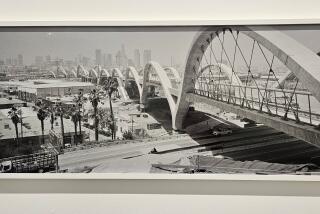Maurice Berger, 63, curator who explored race, dies of presumed COVID-19 complications
- Share via
Maurice Berger, a writer and curator whose prescient work on the nature of art, race and image helped set a framework for the social discourses of today, died of heart failure — presumably from complications related to COVID-19 in Craryville, N.Y., on Sunday. His death was confirmed by representatives at the University of Maryland, Baltimore County (where he served as chief curator of the Center for Art, Design and Visual Culture), as well as New York’s Jewish Museum, where he helped curate numerous exhibitions over the course of his career. Berger was 63.
Berger’s husband, Marvin Heiferman, said via telephone that Berger had contracted a severe flu whose systems were consistent with COVID-19 in the days before his death, but he had been unable to verify whether it was because of coronavirus.
For the record:
9:21 a.m. March 25, 2020An earlier version of this article misspelled the name of the director of New York’s Jewish Museum. It’s Claudia Gould, not Gold. It also misidentified the ICP. It’s the International Center of Photography, not the Institute of Contemporary Photography.
“There was no way to get him tested,” he said.
In an emailed statement to The Times, the Jewish Museum’s director, Claudia Gould, described Berger as “a brilliant visionary with a love for life and a deep sense of humor.” His work “brought inspiration to many of our exhibitions and catalogs.”
Berger was known for his nuanced explorations of race in the book “White Lies: Race and the Myths of Whiteness,” published by Farrar, Straus and Giroux in 2000, and the 2003 exhibition “White: Whiteness and Race in Contemporary Art,” which debuted at the Center for Art, Design and Visual Culture before traveling to the International Center of Photography in New York. They not only explored the inequities of the Black and Latino experience, they examined the privileged position of whiteness — a profound consideration of the issue before such discussions had come to circulate in the culture at large.
“There were not a lot of people talking about this in the 1990s,” says Steven Nelson, a UCLA art historian who is also a professor at the National Gallery of Art in Washington, D.C. “He was just a tireless advocate for talking about race in the art world and how race functions and racism functions. ... This was his battle cry.”
That cry included a now-famous 1990 essay published in Art in America, “Are Art Museums Racist?” — in which he called out institutions that talked about racial inclusion but did little to move the needle. As he wrote: “Not until the white people, who now hold the power in the art world, scrutinize their own motives and attitudes toward people of color, will it be possible to unlearn racism.”
“It was really groundbreaking,” says Nelson, of Berger’s work. “It helped a lot of others find their voices.”
“People are finally picking up on the work that he did,” says Heiferman, who also works as a writer and curator.
Norris also oversaw the installation of the Kinetic Light Installation at LAX, which helped change the airport’s main gate.
It was Berger’s experiences as a youth that drove him to explore these themes. Born to Jewish parents in New York in 1956, he grew up one of a handful of white kids in a low-income housing project on Manhattan’s Lower East in the 1970s — an experience that shaped him socially and intellectually.
“From a very early age, I understood that my skin had a lot of meaning,” he told National Public Radio in 2005. “It made me different in the projects, but it gave me power in the outside world.”
It was a theme he would explore throughout his career.
“As a Jew, I have known anti-Semitism,” he wrote in one of his regular dispatches about race and photography on the New York Times’ Lens blog. “As a gay man, I have known homophobia. But neither has seemed as relentless as the racism I witnessed growing up — a steady drumbeat of slights, thinly veiled hostility and condescension perpetrated by even the most liberal and well-meaning people. It was painful to watch, and as my friends let me know, considerably more painful to endure.”
His New York Times columns earned him an Infinity Award from the ICP in 2018. On that occasion, he told the documentary crew that had been assigned to profile him: “I’m very interested in writing about the things that would normally not be written about.”
From a very early age, I understood that my skin had a lot of meaning.
— Maurice Berger
Berger received his undergraduate degree from Hunter College and later pursued a doctorate in art history and critical theory at the City University of New York.
Over the years, he contributed essays to the New York Times, the Los Angeles Times, Artforum, the Brooklyn Rail and the Village Voice, among other publications. He also curated or helped curate more than two dozen exhibitions covering a wide range of themes, including the photography of Gordon Parks, image-making and the civil rights movement, the critical rivalries of the Abstract Expressionist movement, and the ways in which television was shaped by Modernist art.
The latter two shows were for the Jewish Museum, where he contributed numerous exhibitions over more than 25 years. “His commitment to making all exhibitions and written texts accessible to all was an essential part of his vocabulary,” says Gould.
Berger remained critical of the biases of the art establishment throughout his career, but he once noted that it was art that taught him “how to see.”
“My mentors in art history were rigorous and demanding, teaching me to visually analyze paintings and photographs, both to appreciate their aesthetics and to grasp their underlying cultural meaning,” he wrote in 2017. “I was trained to ‘deconstruct’ images, to evaluate the ways they advanced an agenda or manipulated or inspired viewers.”
It was a lens through which he examined art but also the wider world.
Berger is survived by his husband.
More to Read
Updates
2:02 p.m. March 29, 2020: This story was updated with additional information on the cause of Maurice Berger’s death from Berger’s husband, Marvin Heiferman.
The biggest entertainment stories
Get our big stories about Hollywood, film, television, music, arts, culture and more right in your inbox as soon as they publish.
You may occasionally receive promotional content from the Los Angeles Times.











